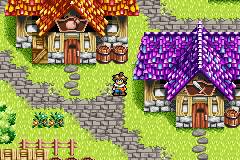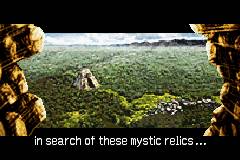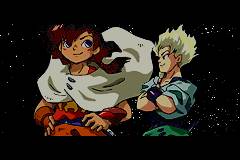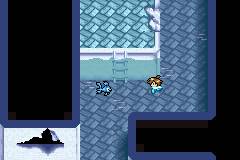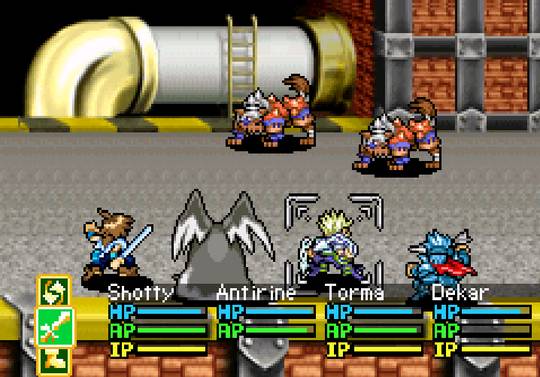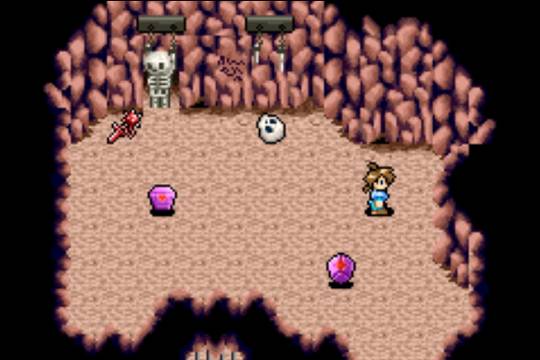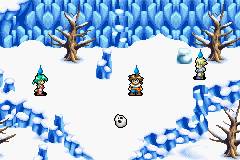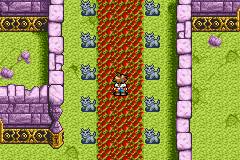Lufia: Ruins of Lore
Lufia: Ruins of Lore is a role playing game that was developed by Atelier Double and was released on the Nintendo GameBoy Advance on May 06, 2003.
| Developer: Atelier Double Publisher: Atlus Release Date: May 06, 2003 Platforms: GBA JustRPG Score: 78% Pros: +Appealing Characters. +Easy to learn combat system. +Interesting story line. Cons: -Poor visuals. -No replay value. -Repetitive. |
Lufia: Ruins of Lore Overview
Lufia: Ruins of Lore is a traditional style role playing game that is part of the popular Lufia series. This game takes place 20 years after the events that occurred in the game Lufia II: Rise of the Sinistrals. Lufia: Ruins of Lore plays much like many other traditional style role playing games but differs in one major area. In this game the player sees every monster he or she is about to fight and the battle on begins when you make contact with that monster. Overall the game is pretty solid for a handheld RPG and fans of the franchise will have a lot to enjoy.
Lufia: Ruins of Lore Screenshots
Lufia: Ruins of Lore Featured Video
Lufia: Ruins of Lore Review
|
The fourth of the series, if I’m not mistaken, and it’s definitely one of the good RPG’s on the GBA. Still…there are some points lacking. |
|
The Good (It’s a classic RPG) You are a boy who basically starts out as any normal person, but get thrust into a journey full of adventure. The formula has often won the hearts of gamers, and despite being done before, Ruins of Lore still delivers. The story itself is important to the game, as you discover the plots of the Gratze Empire, and how the curse placed on you by the Ancients can be removed. |
|
An enjoyable part of the game is the ability to have ‘professions’. These can range from the basic Warrior, Black Mage, Thief, White Mage etc. to the more hidden Alchemist and Knight. Each profession, as you gain experience, will give you special skills that are yours for good, even if you change your profession. The professions also affect your stats, raising attack power for the warrior, raising magic power for the mages, and so forth. Therefore, it is wise to keep a balanced party. Once again, something that’s been done before, but I find this kind of thing very enjoyable, if used well, like inFinal Fantasy Tactics. |
|
As you progress through caverns and labyrinths, you will face many monsters. In a Pokemon-style of game, you can capture these monsters and have them fight by your side, gaining experience and skills along with the rest of the party. They can also become strong enough to evolve, and depending on which elemental stone you use to level them up, they will turn into a different monster. This adds a new level of replayability to the game, as players can attempt to catch and evolve all the monsters, because there are a lot. A whole lot. |
|
The Bad The game is confusing. Not in the sense that you can’t learn how to play, but in the sense that you have no idea what is going on. While I can’t say I was playing the game with my undivided attention, I can say that most games don’t require me to. In Ruins of Lore, while the story is a very important part of the game, you are rarely told about it. What I mean is that once a little story sequence goes by and you are given some story such as “You have been cursed. You should go to this place to remove it”, if you try to figure out what to do, or try to get the name of the town again, all you’ll get it “You should go now”. This often led to hours of me just meandering around the world, trying to figure out the next place to go. While I leveled up a lot, this is not what I like in a story-driven RPG. |
|
The battle system. It’s slow. It’s your standard Final Fantasy turn-based system, but it takes a few seconds for each enemy to attack. Longer, actually. One party member actually takes six or seven seconds to attack, and there is a pause between every attack. What this meant is that even the simplest of battles took too long. Some battles just went on and on and on and on and…you get my point. |
|
The Ugly: The monster catching is a fundamental part of the game. There is a town set up to deal with monsters you catch, what to do with them, and things like that. You can have a total of eight party members, that’s four characters and four monsters. In the game, experience from each monster is divided among the party members, it’s standard fare. This is fine in the beginning of the game when you have two monsters, two characters, filling out the four-person-per-battle quota. However, later in the game, when you have all four characters and still have one, two, three, or even four monsters, you get extremely low amounts of experience from battles because experience is divided between characters that don’t even fight. As you head deeper into dungeons you become a lot weaker than the enemies you face, and that leads to a lot of long periods of leveling up. It gets really slow. |
|
Captured monsters, while an expanded concept in this game from the other Lufia’s, are worthless. They are much, much weaker than the characters and are totally uncontrollable. Okay, not too much of a problem. But when your monsters start healing themselves when they’re already at max, or healing enemies by using a fire spell against a fire element, you start to tear your hair out. |
|
Alas, it seems Lufia must follow the path of shame. It’s a good concept, but it’s just implemented quite poorly. It’s just an idea that has failed to move ahead with the times. For die-hard RPG fans, this isn’t a bad buy. For those new to the whole RPG thing…find another. |
|
Final Grade: 78% |
Lufia: Ruins of Lore Screenshots
Lufia: Ruins of Lore Videos
Lufia: Ruins of Lore Gameplay


